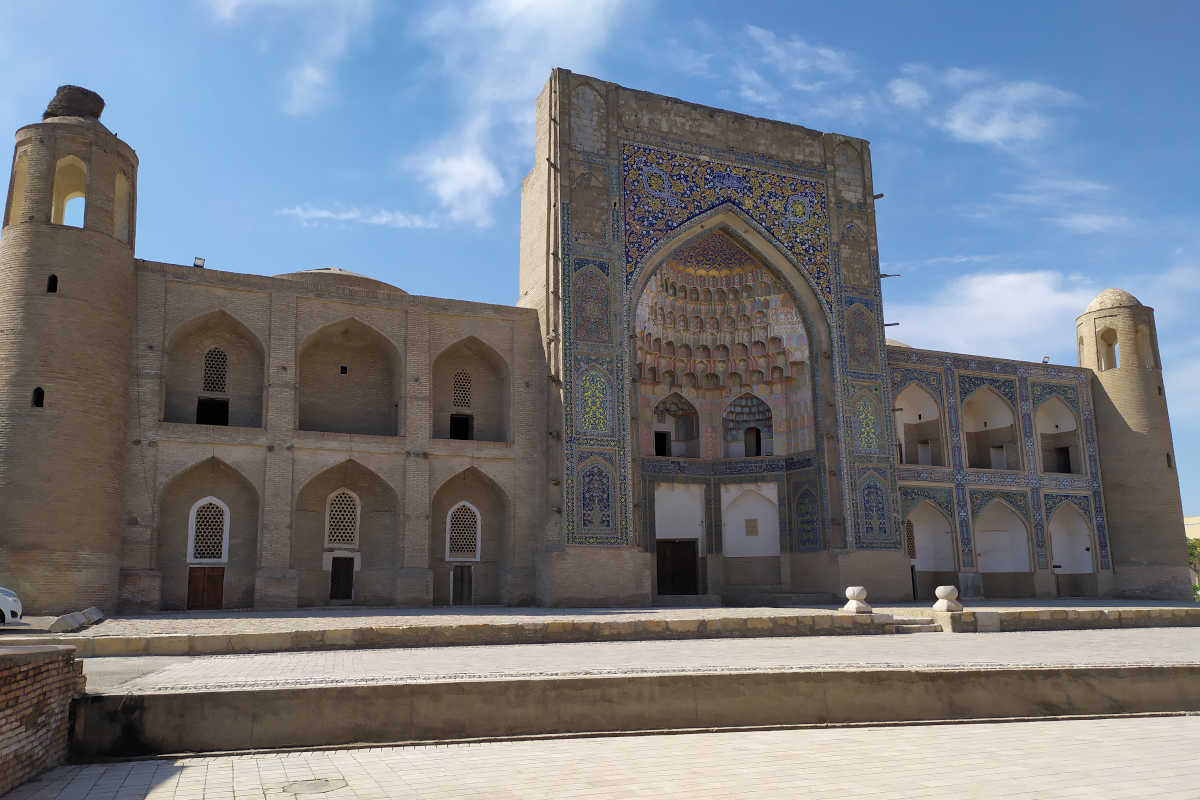Bukhara - Madrasa Abdulaziz Khan

The Abdulaziz Khan madrasah in Bukhara – a masterpiece of Islamic architecture
The Abdulaziz Khan madrasah, built in 1652, is the last of the great madrasahs of Bukhara and an impressive example of the rich architecture of Central Asia. With its expansive courtyard, spacious darskhonas, summer and winter mosques and comfortable hujras, which served as living quarters for the students of the Koran, it epitomises the architectural mastery of its era.
Architectural concept and symbolism
The madrasah was built under the command of Abdulaziz Khan, who ordered its construction in the Persian style. A large inner courtyard, divided by four aiwans, and the imposing entrance portal, which was built according to the ‘kosh’ principle, characterise the overall appearance of the building. The aiwan is particularly fascinating with its multi-faceted design and ornately decorated stalactites.
The ornamentation of the madrasah clearly stands out from other buildings of its time: instead of geometric patterns, colourful depictions of the Chinese dragon and the lucky bird Semurg dominate, symbols of protection and spiritual power. The dominant yellow tones of the decoration lend the building a warm, almost mystical aura.
Another novelty are the fireplaces integrated into the walls, which provide effective heating for the rooms – a testament to the well thought-out functionality of the building. The names of the masters Muhammad Sapih, Mim Hakan and Muhammad Amin are carved into the ornate ornamentation, a testament to the craftsmanship of the time.
A harmonious ensemble
Together with the Ulugbek madrasah, the Abdulaziz Khan madrasah forms an impressive architectural ensemble, whereby the richer design of the Abdulaziz Khan madrasah is particularly striking. It was designed to surpass the neighbouring 15th century masterpiece of the Ulugbek Madrasah. This can be seen in the variety of decorative elements: carved tiles, filigree brick mosaics, relief majolica, marble carvings and ornate gilding.
Interestingly, the Abdulaziz Khan madrasah also became known as the ‘Zargaron madrasah’ in the last century, as it was located in the immediate vicinity of the Zargar jewellery bazaar. Its hujras, designed with a high degree of comfort, made it a symbol of old Bukhara.
Unfinished splendour
Although the madrasah impresses with its architectural sophistication, its construction was never fully completed. Political upheaval and the fall of Abdulaziz Khan led to work being abruptly halted. This explains why the left side of the façade and the right side of the courtyard remained undecorated. The madrasah thus not only symbolises the architecture of its time, but also bears silent witness to the political events that shaped Bukhara.
A place of knowledge and art
Today, the madrasah houses a museum of artistic woodcarving, which presents valuable exhibits such as skilfully carved doors, shutters, tables and dervish sticks from the 19th century. The restoration history of the madrasah also deserves attention: in 1930, the building underwent a comprehensive restoration, in which the famous national master Usto Shirin Muradov was involved. Between 2006 and 2009, the monumental entrance portal was renovated with funds from the Ministry of Foreign Affairs’ Cultural Heritage Preservation Programme.
The Abdulaziz Khan madrasah embodies the rich history and cultural diversity of Bukhara to this day. It is not only a place of learning, but also a symbol of the fusion of Islamic architectural traditions with local and Persian elements. This unique building captivates visitors with its splendour and is a reminder of Bukhara’s heyday as a centre of knowledge and culture.
